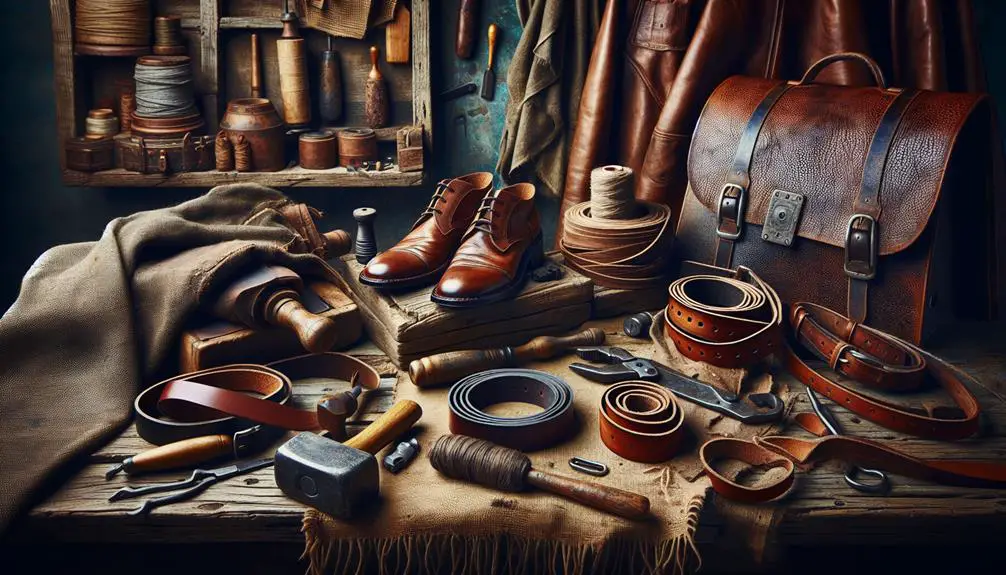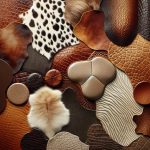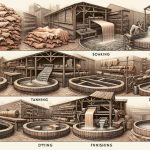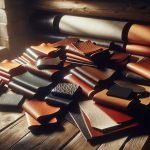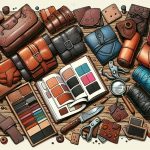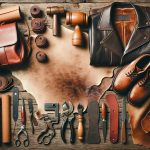When I think about real leather, I'm talking about genuine leather made from animal hides. It's sometimes referred to simply as "leather," but within that, there are different types like full grain, top grain, and bonded leather. Full grain leather is the most high-quality stuff—it shows the natural imperfections of the hide and ages really well. Top grain is a bit more processed but still tough and gorgeous as it ages. Then there's bonded leather, which is less durable and made from leather scraps. Each type has its unique traits and uses, and knowing the difference matters a lot! There's more stuff to uncover about how these types perform over time.
Table of Contents
Key Takeaways
- Real leather is often termed "genuine leather."
- High-quality real leather includes "full-grain leather" and "top-grain leather."
- Lower quality real leather is labeled as "bonded leather."
- "Full-grain leather" retains the hide's natural surface and is the highest quality.
- "Top-grain leather" is slightly processed for uniformity but maintains durability.
Understanding Real Leather
To really get what real leather is, we've got to start with the basics. When you hear terms like Real Leather or Genuine Leather, it means you're dealing with the real deal—authentic stuff crafted from animal hides. This isn't just any material; it's durable, flexible, and has a unique character that synthetics can't match.
Let's talk about how you can spot real leather. First, the smell of real leather is distinct—rich and earthy, unlike synthetic materials that often have a chemical scent. Then there's the touch; real leather feels smooth, sometimes with a bit of graininess depending on the finish. It's not just about looks or feels, though. Real leather changes over time. This is called patina development, and it's a good thing. It means your leather item is aging gracefully, getting richer and more personal with use.
The surface structure of real leather is another giveaway. It's irregular, with pores and variations that synthetic materials can't accurately mimic. So next time you're examining a leather product, pay close attention to these details—they're your clues to authenticity and quality.
Types of Real Leather
So, let's talk about the different types of real leather.
First up, there's full grain leather, which is really tough and keeps its natural marks.
Then, there's top grain leather, perfect for everyday items because it's more refined.
And finally, there's bonded leather, which is made from leftover hide bits.
Full Grain Leather Qualities
Full grain leather, the top-tier type of real leather, boasts unmatched durability and a distinctive appearance that ages beautifully. It's the highest quality you can get. This leather shows off natural imperfections and unique characteristics that really tell a story.
Plus, it's super thick and durable. Over time, it develops this incredible, beautiful patina that just screams luxury. You'll see it often in high-end products where folks really value strength and longevity.
Whether it's a wallet, belt, or fancy bag, full grain leather stands out. It's not just tough; it's classy. If you're into stuff that gets better with age, this is your go-to material. Trust me, it's worth every penny.
Top Grain Leather Uses
Top grain leather is a go-to for crafting high-quality, stylish accessories like wallets, belts, and luxury handbags. It's the sweet spot for those who want luxury goods without splurging too much.
What's great about this leather is its versatility. You can find it in a slew of dyed colors, matching any style or preference. This makes it a top pick for fashion-forward folks.
Besides looking good, top grain leather is seriously durable. It handles daily wear like a champ and even develops a unique patina that adds character over time. Whether it's your daily wallet, that chic belt, or a trendy handbag, this leather combines practicality with class.
Bonded Leather Overview
Bonded leather offers an affordable alternative, using scraps of real leather combined with a polyurethane binder. It's kinda like the hotdog of the leather world — a mix of bits and pieces. Here's the scoop: bonded leather's got only 10-20% real leather. That's not much, right?
This stuff is cheaper than the full leather experience. But keep in mind, it's less durable. You might see it start peeling or flaking after a bit. Not exactly heirloom material. However, it does have a uniform appearance and texture which some folks find appealing.
Identifying Genuine Leather
When I'm checking if leather is real, I always start by feeling its texture. Real leather has a unique softness and retains natural lines and marks.
I also give it a good sniff because genuine leather has a distinct, rich smell that fake leather just can't match.
Leather Texture Analysis
Let's dive into how you can spot genuine leather by its texture.
First thing, real leather feels supple, not rigid or plasticky like artificial materials. Run your fingers across it; authentic leather has a natural, uneven texture with visible imperfections. Think scars, wrinkles, or even stretch marks. These aren't flaws but rather signs of quality, showing that the leather is genuine.
Also, real leather develops a patina over time. This patina isn't just a color change but a deepening of its texture and character, making it more beautiful as it ages. Fake leather can't replicate this. If it looks too perfect, too uniform—it's probably not the real deal.
Smell Test Methodology
To identify genuine leather, one effective method is the smell test, which relies on its unique, natural scent. Real leather, thanks to the tanning process and natural oils in the animal hide, has this rich, earthy aroma that artificial leather just can't mimic. When you sniff leather, look for that strong, pleasant smell—a key sign you're dealing with the real deal.
Artificial leather often lacks this distinct natural aroma, often smelling more chemical or plastic-like. So, next time you're trying to figure out if a leather item is genuine, give it a good whiff. This smell test really simplifies the identification process, guiding you away from faux options.
Characteristics of Full-Grain Leather
Full-grain leather is the top-tier choice due to its durability and unique natural markings. It's the highest quality you can get, and here's why it's such a big deal. This type of leather keeps the natural grain from the animal hide, which includes some imperfections. But those aren't flaws; they're proof of its authenticity and add character.
Here's a quick breakdown:
| Feature | Benefit |
|---|---|
| Natural Grain | Adds unique, unreplicated textures |
| Imperfections | Shows authenticity and history |
| Thick and Durable | Withstands wear and tear |
| Patina Development | Enhances beauty over time |
This leather isn't just strong; it's made to last. It gets better with age, developing a patina that makes it more striking the more you use it. Think of it as leather that grows with you, gaining beauty and telling a story that's uniquely yours.
Features of Top Grain Leather
So, let's talk about what makes top grain leather stand out, especially when it comes to durability and maintenance.
It's built tough enough for daily use but still needs some care to keep it looking great.
That balance makes it a top pick for anyone after high-end bags or wallets without too much fuss.
Durability of Top Grain
Top grain leather really stands out for its toughness and ability to handle daily wear and tear. It's great for anyone wanting stuff that lasts. Unlike other leathers, it resists stains and scratches way better. This means I don't freak out every time someone spills something or a pet jumps on the couch. And here's a cool part: it develops this awesome patina over time. It just gets better looking with age!
Because of its durability, top grain leather is perfect for high-end furniture and luxury accessories. It's a smart choice if you're into things that aren't only stylish but also tough. It's the go-to for durability that matches a luxury lifestyle.
Maintenance Requirements
To keep it looking sharp and feeling soft, top grain leather needs regular conditioning. It's the way to go if you adore pieces with a bit of a story, like those handbags or wallets that just get better with age. This leather's ability to develop a rich patina makes it a standout choice.
Here's a quick table on caring for top grain leather:
| Feature | Maintenance Tip |
|---|---|
| Softness & Luster | Regular conditioning |
| Scratch Resistance | Gently buff out marks |
| Stain Resistance | Wipe spills immediately |
| Developing Patina | Allow natural aging |
| Usage in High-End Products | Ideal for handbags |
Stick to these tips, and your leather goods will keep turning heads!
Benefits of Real Leather
Real leather's durability and timeless beauty make it a top choice for those who value quality and style. I've found that its longevity is unmatched compared to synthetic materials. Imagine having a leather jacket or a pair of boots that just get better with age. That's the magic of real leather!
Now, when we talk about natural beauty, nothing beats the unique patina that real leather develops over time. It's like each piece tells its own story. Plus, the various leather grades, like full-grain and top-grain, mean you can choose exactly what suits your needs and tastes. Full-grain leather, in particular, is the highest quality you can get. It's incredibly durable and maintains its strength over years of use.
Besides the luxury feel, I'm also big on sustainability, and real leather scores high here too. It's a natural material, which means it's biodegradable, unlike many synthetic alternatives. This aspect really matters to me because it aligns with my values of reducing environmental impact.
Maintenance and Care Tips
Caring for your real leather items isn't just about keeping them looking good; it's essential for extending their lifespan. Here's how I do it effectively.
First, I always use a leather conditioner. This stuff is crucial because it keeps the leather soft and supple. Without it, leather can dry out and crack, which is a total bummer. I make it a routine to condition every few months.
Next, I'm careful about where I place my leather items. Keeping them out of direct sunlight is a must. Sunlight can be brutal—it dries out leather fast and causes ugly cracking. So, I store my stuff in a cool, dry place. Speaking of storage, that's key for mold prevention. Humidity is the enemy here, so I ensure my storage spots aren't damp.
When it comes to cleaning, I keep it simple. Just a damp cloth and a bit of mild soap do the trick. I avoid harsh chemicals at all costs. They can wreck the leather's finish and weaken the material.
Common Misconceptions
Many folks mistakenly think 'genuine leather' means top quality, but that's not always true. Let me break it down for you. When we talk about real leather vs genuine leather, we're diving into a world where not all that glitters is gold. Genuine leather, despite its appealing name, is actually on the lower end of the quality spectrum.
Real leather can be made from animal hides of cows, goats, or even crocodiles. This variety means there's a broad spectrum of quality and types of leather out there. The best? Full grain leather. It's the real deal. The whole hide, with all its toughness and grain, gives you the highest durability and awesome aging qualities.
Now, genuine leather might sound fancy, but it's often just a mix, sometimes only 10-20% real leather. Understanding the distinction between these types is crucial. It's not just about spotting the difference; it's about knowing what you're actually paying for. So next time you're shopping, remember, the types of leather vary greatly, and mastering these nuances can save you from disappointment and unnecessary expense.
Real Leather Vs Synthetic
Let's dive into how real leather stacks up against synthetic options. When you're deciding between genuine leather and something like PU leather, there are a few key points to consider. Real leather isn't just a material; it's an investment in quality and craftsmanship. It's more durable and ages with a grace that synthetic leather can't match. On the other hand, synthetic options are often cheaper and more uniform in appearance.
Here's a quick table to break down the differences:
| Feature | Real Leather | Synthetic Leather |
|---|---|---|
| Material Source | Animal hide | Plastic polymers |
| Durability | High | Moderate to low |
| Appearance | Natural imperfections | Uniform |
| Aging | Develops patina | May crack or peel |
| Cost | Higher | Lower |
Choosing between real and faux leather depends on what you value. If it's longevity and natural beauty, genuine leather's your best bet. If lower cost and consistent appearance are your priorities, synthetic could work well. Just remember, you often get what you pay for, especially when it comes to materials like these.
Ethical and Environmental Impact
How do the ethical and environmental impacts of real leather compare to synthetic alternatives? Well, let's dive into it. Real leather has its issues, especially concerning ethics and animal welfare. The process isn't just about using an animal's skin; it's about how the entire operation affects our planet. We're talking serious environmental impact here, from deforestation and water pollution to the heavy use of toxic chemicals in tanning processes.
However, it's not all doom and gloom. There's something called sustainable leather, where the focus is on reducing those negative impacts. This includes using ethically sourced leather, which means paying attention to how the animals are treated and how the leather is produced.
On the flip side, synthetic leather, like PU leather, often has a lighter environmental footprint. But here's the kicker, it's not perfect either. The production of synthetic alternatives can still involve harmful chemicals and processes.
To give you a clearer picture, here are some key points:
- Ethical concerns: Real leather involves animal welfare issues.
- Environmental impact: Both leather types contribute, but real leather often leads heavier.
- Sustainable practices: Opting for ethically sourced leather can make a difference.
- Tanning processes: These are crucial in determining the overall environmental footprint.
Choosing wisely matters, and understanding these impacts is the first step.
Choosing Quality Leather Products
After exploring the ethical and environmental concerns, it's also important to know how to pick the best leather products available. When I'm shopping for leather, I always check the labels first. The keywords 'full-grain' and 'top-grain' are what I look for to ensure I'm getting top quality.
Full-grain leather is my go-to because it includes the natural imperfections of the hide, which I love. These marks add unique character and also tell me about the leather's durability and quality. It's the whole package—looks and longevity.
Top-grain leather is also a good choice. It has a more uniform look and a premium feel, making it great for items where you want a bit more refinement without sacrificing much quality.
I tend to be wary of products labeled just as 'genuine leather' because this term can be misleading. It's often not as durable and lacks the longevity of the higher-tier leathers. Although more affordable, it mightn't be the best value in the long run.
Frequently Asked Questions
What Is Original Leather Called?
I've always known original leather as "genuine leather." It's also called full-grain, top-grain, or split grain depending on the quality. Look for those terms to make sure you're getting the real deal.
What Is 100% Leather Called?
I've learned that 100% leather is simply called "full grain leather." It's the top-notch stuff you want if you're after durability and quality. No synthetics, just pure, real leather through and through.
What Is High Quality Leather Called?
High-quality leather is called full-grain leather. It's the best type, keeping the skin's full thickness, so it shows unique marks and gets better with age. It's durable and feels luxurious.
What Are the 4 Grades of Leather?
The four grades of leather are full-grain, top-grain, genuine, and bonded. Full-grain's the best, showing natural marks. Top-grain's smoother, genuine has an artificial look, and bonded's made from leather leftovers.
- How Do You Classify Leather? - April 19, 2024
- Where Is Leather Made Called? - April 19, 2024
- Where Is Leather Made? - April 19, 2024

